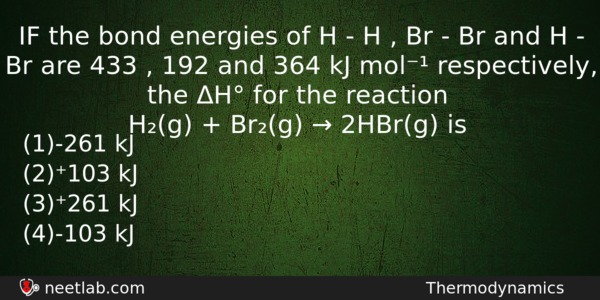| ⇦ | 
| ⇨ |
IF the bond energies of H – H , Br – Br and H – Br are 433 , 192 and 364 kJ mol⁻¹ respectively, the ΔH° for the reaction
H₂(g) + Br₂(g) → 2HBr(g) is
Options
(a) -261 kJ
(b) ⁺103 kJ
(c) ⁺261 kJ
(d) -103 kJ
Correct Answer:
-103 kJ
Explanation:
H – H + Br – Br → 2H – Br,
(433) + (192) (2 x 364)
=625 =728
(Energyabsorbed) (Energy released)
Net energy released = 728 – 625 = 103 KJ. i.e. ΔH = -103 KJ.
Related Questions: - In Dumas’ method of estimation of nitrogen 0.35g of an organic compound gave 55mL
- 5 mL of N HCl, 20 mL of N/2 H₂SO₄ and 30 mL of N/3 HNO₃ are mixed together
- The shape of cuprammonium ion is
- Roasting is done in
- A drug which is sturcturally related to adrenaline is
Topics: Thermodynamics
(179)
Subject: Chemistry
(2512)
Important MCQs Based on Medical Entrance Examinations To Improve Your NEET Score
- In Dumas’ method of estimation of nitrogen 0.35g of an organic compound gave 55mL
- 5 mL of N HCl, 20 mL of N/2 H₂SO₄ and 30 mL of N/3 HNO₃ are mixed together
- The shape of cuprammonium ion is
- Roasting is done in
- A drug which is sturcturally related to adrenaline is
Topics: Thermodynamics (179)
Subject: Chemistry (2512)
Important MCQs Based on Medical Entrance Examinations To Improve Your NEET Score
18000+ students are using NEETLab to improve their score. What about you?
Solve Previous Year MCQs, Mock Tests, Topicwise Practice Tests, Identify Weak Topics, Formula Flash cards and much more is available in NEETLab Android App to improve your NEET score.
Share this page with your friends

Leave a Reply